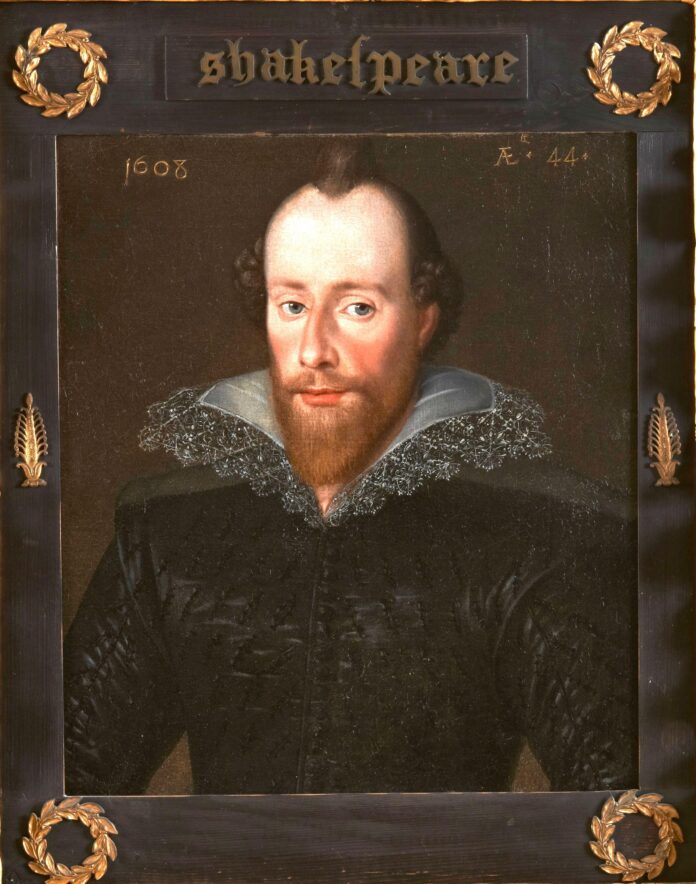The unveiling and proposed £10m sale of an early 17th century portrait, reputedly of William Shakespeare, has caused a stir. The attribution is being debated, but what does the evidence show?
The inner frame of the 20 x 18 inch portrait includes the title Shakespeare, but this is an 18th- or19th-century addition, when the painting was relined.
The figure portrayed is a bearded, balding man in shirt and doublet, with the top left and right of the canvas helpfully inscribed 1608 and AE (aged) 44 – the correct age for the playwright at the time.
A Courtauld Institute examination of the picture in 2016 concluded the pigments were consistent with the period, while its well-preserved state pointed to it having remained in the same location for a lengthy period, possibly centuries.
Cleaning removed a heavy black beard to reveal an original, lighter trimmed and pointed beard.
Removing the frame for closer examination uncovered the stylised letters RP to the top right of the painting—the cypher of Robert Peake the Elder (c.1551-1619), who by 1576 was recorded as being in the pay of the Office of the Revels, which oversaw the performance of plays for Queen Elizabeth I.
Several records show payments to Peake for commissions, including for a portrait of Henry, Prince of Wales in 1603. Peake became Serjeant-Painter to King James I around 1607.
Peake’s son William (c.1580-1639) owned a successful print shop and knew the engraver Martin Droeshout, who created the image of Shakespeare for the 1623 First Folio of the Collected Works. The National Portrait Gallery holds Droeshout engravings published by the Peake family press.
Lionel Cust, in his book Shakespeare’s England, notes William Peake’s eminence alongside Messrs Sudbury and Humble as the printers of choice for celebrity portraits of the day.
Further connections come from the Office of the Revels. Both Shakespeare and Robert Peake lived nearby and worked there before and after it moved from Clerkenwell to Blackfriars in 1608. Peake painted scenery and other items for the theatre, the only indoor establishment of the King’s Men or the Shakespeare Company, where Shakespeare rehearsed and staged many of his plays.
With Shakespeare at the height of his powers in 1608, a portrait from that time would make sense. Who better to commission than the Serjeant-Painter to the King, whom he must have known through the theatre? Accounts show that Queen Anne, a supporter of the King’s Men, was also a patron of Peake at the time.
Comparisons between the picture and the only other two confirmed portraits of Shakespeare are trickier. The bust on his Stratford-upon-Avon tomb has been much changed and restored over the years and is not thought a good likeness. That leaves the Droeshout engraving for the First Folio. Researchers compared the left eye, with its drooping lid and slight deformity possibly caused by cancer. Both portraits have the thick eyelid, but as hard evidence, this seems a stretch.
The Danby family, who had direct connections with Shakespeare, are known to have had the painting on display at Swinton Hall from 1860-65, and probably for a great deal longer.
In summary, the evidence is circumstantial but fairly compelling: the portrait is of the right period and carries a contemporary inscription giving the correct age for Shakespeare; Peake—arguably the pre-eminent official court artist of the time—has been identified as an associate of the playwright; and the artist’s son printed works by the creator of the First Folio’s portrait engraving.
Duncan Phillips, who uncovered the connections between Peake, Droeshout and the portrait’s history, says: “There is more evidence for this portrait of Shakespeare than any other known painting of the playwright.”
The canvas is being sold by its anonymous owner by private treaty without an auction and is currently on show at Grosvenor House hotel in west London.

























